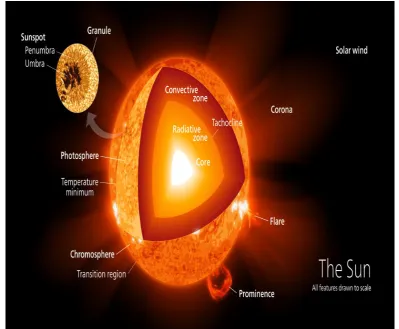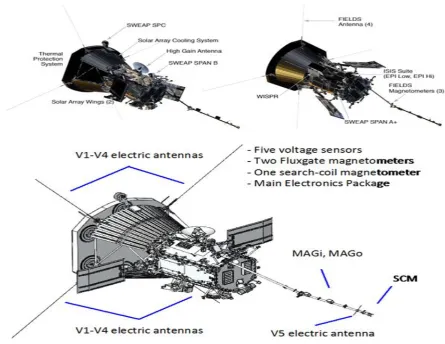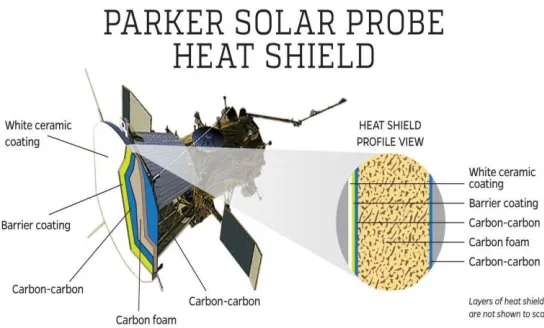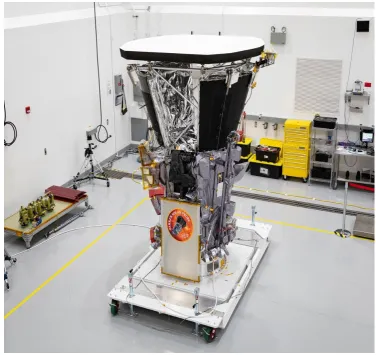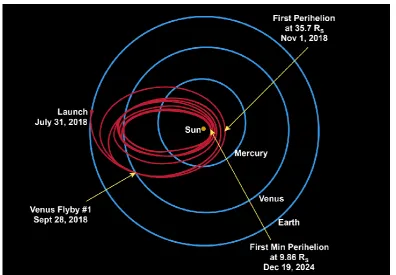Rohit. World Journal of Engineering Research and Technology
THE SURVEY OF PARKER SOLAR PROBE
Rohit Raju Nikam*
B-Tech Mechanical Engineer, MIT-ADT University, School of Engineering, Pune.
Article Received on 07/02/2019 Article Revised on 28/02/2019 Article Accepted on 21/03/2019
ABSTRACT
NASA’s Parker Solar Probe mission will revolutionize our understanding of the Sun. The mission will “touch the Sun,” flying
directly through the solar corona, facing brutal heat and radiation
conditions and providing unprecedented, close-up observations of the
star we live with. These observations will address unsolved science
questions such as how the Sun’s corona is heated and how the solar wind is accelerated. It
will also benefit humans on the ground by making critical contributions to our ability to
forecast major space weather events that impact life and technology on Earth. Such
information can shed light not only on how the Sun drives the space environment in our own
solar system, but also provide insight into other stars throughout the universe. In this paper
we summarize the development of solar probe including working, assembly, inspection and
maintenance.
KEYWORDS: Solar corona, solar probe, space weather. INTRODUCTION
Parker solar probe (previously Solar Probe, Solar Probe Plus, or Solar Probe+,
abbreviated PSP) is a NASA robotic spacecraft launched in 2018 and currently en route to
probe the outer corona of the Sun. It will approach to within 9.86 solar radii (6.9 million
kilometers or 4.3 million miles) from the center of the Sun and by 2025 will travel, at closest
approach, as fast as 690,000 km/h (430,000 mph), or 0.064% the speed of light.
The project was announced in the fiscal 2009 budget year. The cost of the project is US$1.5
billion. Johns Hopkins University Applied physics laboratory designed and built the
World Journal of Engineering Research and Technology
WJERT
www.wjert.org
SJIF Impact Factor: 5.218*Corresponding Author
Rohit Raju Nikam
B-Tech Mechanical
Engineer, MIT-ADT
University, School of
spacecraft, which was launched on August 12, 2018. It became the first NASA spacecraft
named after a living person, honoring physicist Eugene Parker, professor emeritus at
the University of Chicago. The Parker Solar Probe concept originates from a
predecessor Solar Orbiter project conceived in the 1990s. Similar in design and objectives,
the Solar Probe mission served as one of the centerpieces of the eponymous Outer
Planet/Solar Probe (OPSP) program formulated by NASA. The first three missions of the
program were planned to be: the Solar Orbiter, the Pluto and Kuiper belt reconnaissance
mission Pluto Kuiper Express, and the Europa Orbiter astrobiology mission focused
on Europa.
The original Solar Probe design used a gravity assist from Jupiter to enter a polar orbit which
dropped almost directly toward the Sun. While this explored the important solar poles and
came even closer to the surface (3 R☉, a perihelion of 4 R☉), the extreme variation in solar
irradiance made for an expensive mission and required a radioisotope thermal generator for
power. The trip to Jupiter also made for a long mission (3 1⁄2 years to first solar perihelion, 8
years to second).
Objectives
To understand the concept of solar probe Familiarize yourself with parts of solar probe. To know about solar corona.
As we know, we live in sun’s atmosphere. So this mission will help us to know about the
connection in the Sun and the Earth.
Because, still there is some mystery about the sun so we have to go closer to our star.
Solar Corona
At times of total eclipse, observations of the corona are possible because radiation from the
solar disk is masked by the Moon. What is normally observed is the so-called K-corona. The
white light from the corona is due to Thomson scattering of photospheric light by free
electrons in the coronal plasma. The intensity ratio of light from the corona (close to the solar
surface) to light from the photosphere is less than 10-5; this is why the corona can only be
seen when the solar disk is blocked out. The visible structure of the corona during eclipses is
due to the variations of the total electron content in the corona, i.e. the integrated electron
density along the line-of-sight.
A corona (Latin, 'crown') is an aura of plasma that surrounds the Sun and other stars. The
Sun's corona extends millions of kilometers into outer space and is most easily seen during a
total solar eclipse, but it is also observable with a coronagraph. The word corona is
a Latin word meaning "crown", from the Ancient Greek korone (korōnè, “garland, wreath”).
Spectroscopy measurements indicate strong ionization in the corona and a plasma
temperature in excess of 1,000,000 kelvins, much hotter than the surface of the Sun. Light
from the corona comes from three primary sources, from the same volume of space.
The K-corona (K for kontinuierlich, "continuous" in German) is created by
sunlight scattering off free electrons; Doppler broadening of the reflected
photospheric absorption lines spreads them so greatly as to completely obscure them, giving
the spectral appearance of a continuum with no absorption lines. The F-corona
(F for Fraunhofer) is created by sunlight bouncing off dust particles, and is observable
because its light contains the Fraunhofer absorption lines that are seen in raw sunlight; the
F-corona extends to very high elongation angles from the Sun, where it is called the zodiacal
light. The E-corona (E for emission) is due to spectral emission lines produced by ions that
are present in the coronal plasma; it may be observed in broad or forbidden or hot spectral
Fig 2.1: Sun’s Corona.
Features occurring above the Sun's surface (photosphere)
Table 2.1: Features occurring above the Sun's surface (photosphere).
Chromospheric features Coronal features
Chromospheric Network
web like pattern formed by magnetic field lines related to super granules
Plage
bright patches surrounding sunspots and associated with concentrations of magnetic field lines
Prominences/Filaments
dense clouds of material suspended above the surface of the Sun by magnetic field line loops, called prominences when seen on the limb of the Sun, otherwise filaments; can remain quiet for days or weeks, but can also erupt within few minutes
Spicules
small, jet-like eruptions in the Chromospheric network lasting a few minutes only
Solar flares
huge explosions with time scales of only a few minutes
Coronal Holes
source of high-speed solar wind Coronal Loops
closed magnetic field line loops around sunspots and active regions; can last for days or weeks if not associated with solar flares Coronal Mass Ejections
(CMEs) huge bubbles of gas ejected from the Sun over the course of several hours
Helmet Streamers
source of low-speed solar wind; network of magnetic loops with dense plasma connecting the sunspots in active regions, typically occurring above prominences
Polar Plumes
Fig. 2.2: sun’s corona and solar wind. Spacecraft
The Parker Solar Probe will be the first spacecraft to fly into the low solar corona. It will
assess the structure and dynamics of the Sun's coronal plasma and magnetic field, the energy
flow that heats the solar corona and impels the solar wind, and the mechanisms that
accelerate energetic particles.
Parker Solar Probe Heat Shield
The eight-foot-diameter heat shield will safeguard everything within its umbra, the shadow it
casts on the spacecraft. At Parker Solar Probe’s closest approach to the Sun, temperatures on
the heat shield will reach nearly 2,500 degrees Fahrenheit, but the spacecraft and its
instruments will be kept at a relatively comfortable temperature of about 85 degrees
Fahrenheit.
The heat shield is made of two panels of superheated carbon-carbon composite sandwiching a
lightweight 4.5-inch-thick carbon foam core. The Sun-facing side of the heat shield is also
sprayed with a specially formulated white coating to reflect as much of the Sun’s energy
away from the spacecraft as possible.
The heat shield itself weighs only about 160 pounds — here on Earth, the foam core is 97
percent air. Because Parker Solar Probe travels so fast — 430,000 miles per hour at its closest
approach to the Sun, fast enough to travel from Philadelphia to Washington, D.C., in about
one second — the shield and spacecraft have to be light to achieve the needed orbit.
The reinstallation of the Thermal Protection System — which was briefly attached to the
spacecraft during testing at the Johns Hopkins Applied Physics Lab in Laurel, Maryland, in
fall 2017 — marks the first time in months that Parker Solar Probe has been fully integrated.
The heat shield and spacecraft underwent testing and evaluation separately at NASA’s
Goddard Space Flight Center in Greenbelt, Maryland, before shipping out to Astrotech Space
Operations in Titusville, Florida, in April 2018. With the recent reunification, Parker Solar
Probe inches closer to launch and toward the Sun.
Parker solar probe Instruments
Parker Solar Probe works under extreme conditions as it gathers data in the Sun’s corona,
grazing closer to our star than any spacecraft before. Its four instrument suites characterize
the dynamic region close to the Sun by measuring particles and electric and magnetic fields,
and each was specially designed to withstand the harsh radiation and temperatures they will
encounter.
Fields
Surveyor of the invisible forces, the FIELDS instrument suite captures the scale and shape of
electric and magnetic fields in the Sun’s atmosphere. FIELDS measures waves and
turbulence in the inner heliosphere with high time resolution to understand the fields
associated with waves, shocks and magnetic reconnection, a process by which magnetic field
lines explosively realign.
FIELDS was designed, built, and is operated by a team lead by the Space Sciences
Laboratory at the University of California, Berkeley (principal investigator Stuart D. Bale).
Wisper
The Wide-Field Imager for Parker Solar Probe is the only imaging instrument aboard the
spacecraft. WISPR looks at the large-scale structure of the corona and solar wind before the
spacecraft flies through it. About the size of a shoebox, WISPR takes images from afar of
structures like coronal mass ejections, or CMEs, jets and other ejecta from the Sun. These
structures travel out from the Sun and eventually overtake the spacecraft, where the
spacecraft’s other instruments take in-situ measurements. WISPR helps link what’s
happening in the large-scale coronal structure to the detailed physical measurements being
captured directly in the near-Sun environment.
WISPR was designed and developed by the Solar and Heliophysics Physics Branch at the
Naval Research Laboratory in Washington, D.C. (principal investigator Russell Howard),
which will also develop the observing program.
Sweap
The Solar Wind Electrons Alphas and Protons investigation, or SWEAP, gathers observations
using two complementary instruments: the Solar Probe Cup, or SPC, and the Solar Probe
electrons, protons and helium ions — and measure such properties as velocity, density, and
temperature to improve our understanding of the solar wind and coronal plasma.
SWEAP was built mainly at the Smithsonian Astrophysical Observatory in Cambridge,
Massachusetts, and at the Space Sciences Laboratory at the University of California,
Berkeley. The institutions jointly operate the instrument. The principal investigator is Justin
Kasper from the University of Michigan.
Isois
The Integrated Science Investigation of the Sun — ISOIS, pronounced “ee-sis” and including
the symbol for the Sun in its acronym — uses two complementary instruments in one
combined scientific investigation to measure particles across a wide range of energies. By
measuring electrons, protons and ions, ISOIS will understand the particles’ lifecycles —
where they came from, how they became accelerated and how they move out from the Sun
through interplanetary space. The two energetic particle instruments on ISOIS are called
EPI-Lo and EPI-Hi (EPI stands for Energetic Particle Instrument).
ISʘIS is led by Princeton University in Princeton, New Jersey (principal investigator David
McComas), and was built largely at the Johns Hopkins Applied Physics Laboratory in Laurel,
Maryland, and Caltech, in Pasadena, California, with significant contributions from
Southwest Research Institute in San Antonio, Texas, and NASA’s Goddard Space Flight Center in Greenbelt, Maryland. The ISʘIS Science Operations Center is operated at the
Fig. 3.2.1: Actual parker solar probe. Trajectory
The Parker Solar Probe mission design uses repeated gravity assists at Venus to
incrementally decrease its orbital perihelion to achieve a final altitude (above the surface) of
approximately 8.5 solar radii, or about 6×106 km (3.7×106 mi; 0.040 AU). The spacecraft
trajectory will include seven Venus flybys over nearly seven years to gradually shrink its
elliptical orbit around the Sun, for a total of 24 orbits.[1] The near Sun radiation environment
is predicted to cause spacecraft charging effects, radiation damage in materials and
electronics, and communication interruptions, so the orbit will be highly elliptical with short
times spent near the Sun.
The trajectory requires high launch energy, so the probe was launched on a Delta IV
Heavy class launch vehicle and an upper stage based on the STAR 48BV solid rocket motor.
Interplanetary gravity assists will provide further deceleration relative to its heliocentric orbit,
which will result in a heliocentric speed record at perihelion. As the probe passes around
it the fastest manmade object, almost three times as fast as the current record holder,
Helios-B. Like every object in an orbit, due to gravity the spacecraft will accelerate as it nears
perihelion, then slow down again afterward until it reaches its aphelion.
Fig. 4.1: Probe Trajectory. Timeline
Year Events
2015 March: Critical design review (CDR) 2016
May: System integration review. July: KDP-D
July: Start of integration and testing. 2017
Begin March 2017: Instrument deliveries. Begin August 2017: Observatory system testing. Fall 2017: Shipment of observatory to GSFC. 2018
Spring 2018: Shipment of observatory to cape Canaveral. August 12, 2018: Launch-3.31 a.m. EDT (7:31 UTC)
October 3, 2018: Venus Flyby #1-4:44 a.m. EDT (8:44 UTC)
November 5, 2018: Perihelion #1-10:20 p.m. EST (Nov. 6, 2018 at 03:27 UTC)
2019
January 19, 2019: Aphelion#1
January 20, 2019: Second orbit begins. April 4,2019: Perihelion #2
September 1, 2019: Perihelion #3 December 26, 2019: Venus flyby #2 2020
September 27,2020: Perihelion #6
2021
January 17,2021: Perihelion #7 February 20,2021: Venus flyby#4 April 29,2021: Perihelion #8 August 9, 2021: Perihelion #9 October 16, 2021: Venus flyby#5 November 21, 2021: Perihelion #10 2022
February 25, 2022: Perihelion #11 June 1,2022: Perihelion #12 September 6, 2022: Perihelion #13 December 11, 2022: Perihelion #14
2023
March 17, 2023: Perihelion #15 June 22, 2023: Perihelion #16 August 21, 2023: Venus flyby#6 September 27, 2023: Perihelion #17 December 29, 2023: Perihelion #18
2024
March 30, 2024: Perihelion #19 June 30, 2024: Perihelion #20 September 30, 2024: Perihelion #21
November 6, 2024: Venus fyby#7 Final Venus flyby December 24, 2024: Perihelion #22 First close approach 2025 March 22, 2025: Perihelion #23
June 19, 2025: Perihelion #24 CONCLUSION
In this paper we define the development of parker solar probe, its various parts, their function
and the NASA’s mission to touch the sun. The Parker solar Program’s storied history is vast
and well documented. Understanding the design and operations of this unique and complex
vehicle is not confined to the study of one program, but of many. It touches on only a handful
of the lessons that were learned through the various supersonic and hypersonic research
programs that laid the foundation for Parker solar probe.
REFERANCES
1. Applied Physics Laboratory (November 19). "Feasible Mission Designs for Solar Probe
plus to Launch in 2015, 2016, 2017, or 2018" (PDF). John Hopkins University, 2008.
2. Chang, Kenneth (August 12, 2018). "Parker Solar Probe Launches on NASA Voyage to
'Touch the Sun'". THE NEW YOURK TIMES. Retrieved August 12, 2018.
3. How NASA's New Solar Probe Will 'Touch' the Sun on Historic Mission. Meghan
Bartels, Space.com. August 9, 2018.
